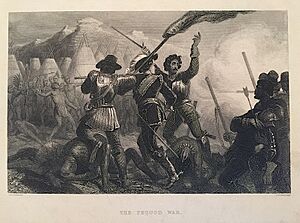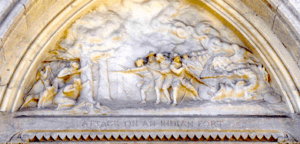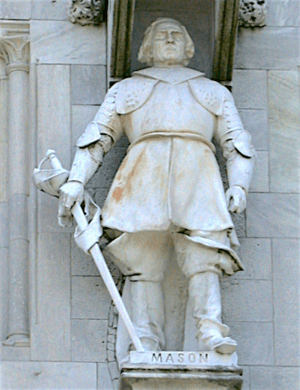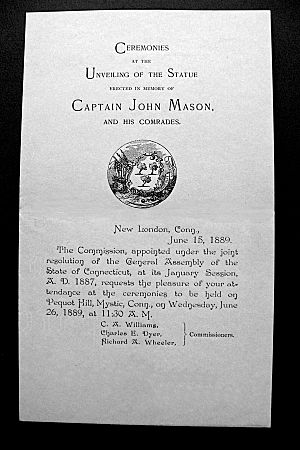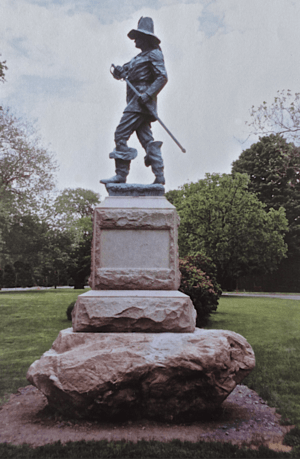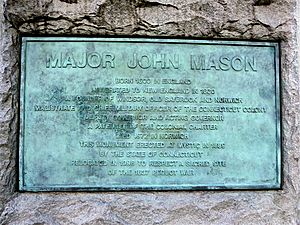John Mason (c. 1600–1672) facts for kids
Quick facts for kids
John Mason
|
|
|---|---|
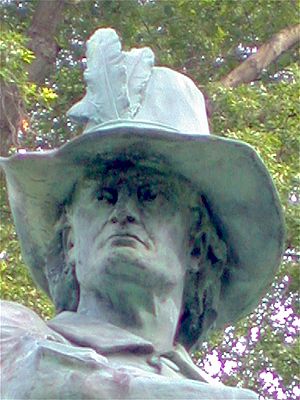 |
|
| 8th Deputy Governor of the Connecticut Colony | |
| In office 1660–1669 |
|
| Preceded by | John Winthrop the Younger |
| Succeeded by | William Leete |
| Personal details | |
| Born | October 1600 Ravensthorpe, Northamptonshire, England |
| Died | January 30, 1672 (aged 71) Norwich, Connecticut Colony. British America |
| Spouse | Anne Peck |
| Children | 8 |
| Signature | |
| Nickname | "The Major" |
| Military service | |
| Allegiance | |
| Branch/service | English Army Massachusetts Bay Militia Connecticut Militia |
| Rank | Major |
| Battles/wars | Siege of Breda Siege of 's-Hertogenbosch Pequot War |
John Mason (born October 1600 – died January 30, 1672) was an English settler, soldier, and leader in the Connecticut Colony. He was also the Deputy Governor. Mason is most famous for leading a group of Puritan settlers and their Native American friends. They attacked a Pequot Fort in an event called the Mystic Massacre. This battle greatly changed the power of the Pequot tribe in southeastern Connecticut.
Contents
John Mason's Early Life and Training
John Mason was born in Ravensthorpe, Northamptonshire, England. We know he was baptized on October 5, 1600. Not much is known about his childhood.
Mason was well educated. He joined the military in 1624. He then went to the Netherlands to fight in the Thirty Years' War. This war lasted from 1618 to 1648. There, he learned important military skills. He first fought in the Breda Campaign. His later actions in New England show he was trained as a military engineer.
By 1629, he was a lieutenant. He took part in the Siege of 's-Hertogenbosch. He served under General Sir Horace Vere.
Life in America: A New Beginning
In 1632, John Mason moved to America. He joined many Puritans who were leaving England. He sailed to the Massachusetts Bay Colony and settled in Dorchester. There, he quickly became the captain of the local militia.
In 1633, he led the first American naval group. They chased the pirate Dixie Bull out of New England waters. He also helped build the first forts on Castle Island in Boston Harbor. In 1634, he was chosen to represent Dorchester in the Massachusetts General Court. He was allowed to move to the rich Connecticut River valley.
In 1635, he settled in Windsor, Connecticut. He lived there for 12 years. He served as a civil Magistrate and military leader. In 1640, he married Anne Peck. They had eight children together.
The Pequot War: A Major Conflict (1636–1638)
The main battle of the Pequot War happened on May 26, 1637. Colonial forces, led by Captain John Mason, attacked a fortified Pequot village at Mystic. About 20 soldiers entered the fort. They were quickly outnumbered. To create confusion and escape, they used fire. The fire trapped most of the Pequots inside. Those who got out were killed by soldiers surrounding the fort. Only a few of the 500 people inside survived. This event became known as the Battle of Mistick Fort.
As the soldiers left, they were attacked by warriors from another village. But the Pequots suffered heavy losses again. These defeats weakened the tribe. They decided to move west toward the Hudson River area. The colonists chased them along the coast. More fights happened at Sachem's Head and the Fairfield swamp. Many more Pequots died or were captured. The Pequot leader, Sassacus, was killed by the Mohawks.
Mason wrote about his experiences in a book called Major Mason's Brief History of the Pequot War. It was first printed in 1677.
Mason's most important role was leading the Colonial forces in the Pequot War in 1637. This was the first major conflict in Southern New England. The powerful Pequot Tribe had taken over other local tribes. They had also killed many settlers and destroyed crops. The Massachusetts Bay Colony declared war. The new Connecticut Colony quickly joined the fight.
The Pequots had more people than the colonists. But they had weaker weapons and fighting methods. The colonists had help from Native American allies. These included Mohegan leader Uncas and Wequash Cooke. Uncas and Mason became close friends. This short but important war changed American society forever. The battle at Mistick Fort was shown on the History Channel. It is a key event when studying the history of the colonial era. After this victory, Mason was promoted to major. He received land as a reward. Mason's Island stayed in his family for over 250 years.
After the Pequot War: New Roles
In 1640, a big change happened for the Connecticut River Valley. Springfield, Massachusetts had been part of the Connecticut Colony. But grain was scarce, and cattle were dying. The settlements of Windsor and Hartford asked William Pynchon of Springfield to buy corn. The Native Americans refused to sell corn at fair prices. Mason was sent to Springfield with "money in one hand and a sword in the other."
Mason threatened the local Native Americans with war if they didn't sell corn. They agreed to sell. But Mason's forceful way made them distrust the English colonists more. Pynchon believed in talking things out. Mason believed in using force if needed. This difference caused arguments between them. Springfield then decided to leave the Connecticut Colony. It joined the Massachusetts Bay Colony.
In 1645, Sir Thomas Fairfax asked Major Mason to return to England. He wanted Mason to join his army in the English Civil War. Mason was offered a high rank. But he chose to stay in Connecticut.
In 1647, Mason took command of Saybrook Fort. This fort controlled trade routes. The fort burned down, but a new one was quickly built. He stayed there for 12 years. He served as a Commissioner for the United Colonies. He was also the chief military officer and a peacekeeper. He often helped buy Native American lands and settle arguments. His friend Uncas caused many of these arguments. Mason was a great leader. He was offered a job to move to the Delaware River area. But he stayed in Connecticut.
Founding of Norwich: A New Town
In 1659, Major Mason moved from the mouth of the Connecticut River. He went to the head of the Thames River. He moved with his son-in-law, Rev. James Fitch, and many Saybrook residents. They founded the town of Norwich, Connecticut. The land was bought from Mohegan leader Uncas. Uncas also gave Mason control over his tribe's lands. This led to long legal battles over land rights. These cases lasted for 70 years.
In Norwich, John Mason served as Deputy Governor for nine years (1660 to 1669). He helped write the Connecticut Charter. He was acting Governor from 1661 to 1663. This was while Governor John Winthrop Jr. went to England. He needed to get the Charter approved by King Charles II.
John Mason was a very trusted man in Connecticut. He was important in both civil and military matters. In his later years, official records just called him "the Major."
Later Life and Passing
In 1670, Mason helped settle a border dispute. It was between Rhode Island and Connecticut.
In 1669, he retired due to old age and illness. He suffered from cancer in his last years. He passed away on January 30, 1672. He is buried in the Post-Gager cemetery in Norwichtown, Connecticut. His grave is unmarked.
John Mason's Family
John Mason married his first wife in 1634. Her name is not known. She passed away in 1638. They had a daughter named Israel, born in 1635. Israel married John Bissell Jr. in 1657.
Mason married Anne Peck in July 1639. Anne was born in England in 1619. She passed away in 1671 in Norwich, Connecticut. She was the daughter of Rev. Robert Peck. He was an important Puritan clergyman.
John and Anne had seven children: Priscilla (b. 1641), Samuel (b. 1644), John (b. 1646), Rachel (b. 1648), Ann (b. 1650), Daniel (b. 1652), and Elizabeth (b. 1654).
Mason's sons Samuel, John, and Daniel also became military officers and public servants. Many of his later family members became military officers, doctors, lawyers, and reverends in America.
Memorials and Honors
After the Civil War, many statues of heroes were built. Citizens of Mystic, Connecticut decided to create a large bronze and granite statue of Major John Mason. It was for his role in the 1637 Pequot War. In 1889, the statue was placed in Mystic. It was near where the Mystic Massacre was thought to have happened.
The Colonial government had said the Pequot Tribe was extinct. But some survivors and their families remained. They complained about the statue being on their sacred site. In the early 1990s, modern-day Pequots gained federal recognition. Their complaints about the statue could no longer be ignored.
In 1996, the State of Connecticut moved the statue. It was moved to the Palisado Green in Windsor, Connecticut. This is where John Mason lived during the war. The old plaque, which praised him for the war, was removed. A new plaque was put in its place. It describes Mason's entire career. This made the statue represent his whole life of public service. This included his many achievements as a founder of the Connecticut Colony.
Here are some of his important roles:
- Commander of the first American Naval task force against the pirate Dixie Bull in 1633.
- Civil Engineer for early forts at Castle Island in Boston Harbor in 1634.
- Representative for Dorchester to the Massachusetts Bay Colony General Court from 1634–1635.
- Captain and Commander of Colonial forces in the Pequot War in 1637.
- Representative for Windsor to the Connecticut Court from 1637–1641.
- Assistant to the Connecticut Court from 1642–1659 and 1669–71.
- Commander of Saybrook Fort from 1647–1659.
- Chief military officer of the United Colonies from 1654–1672.
- Deputy Governor of Connecticut Colony from 1660–1668.
- Acting Governor from 1661 to 1663.
- Commissioner for the United Colonies several times.
- Holder of the original Connecticut Constitution - Royal Charter in 1662.
- Overseer (first Indian Agent) and Administrator of Mohegan Lands from 1659–1672.
In 1859, a monument was built in Norwich. It honored the town's 200th anniversary. This monument is also called the Mason Monument. It lists the names of all 38 original settlers.
Images for kids


